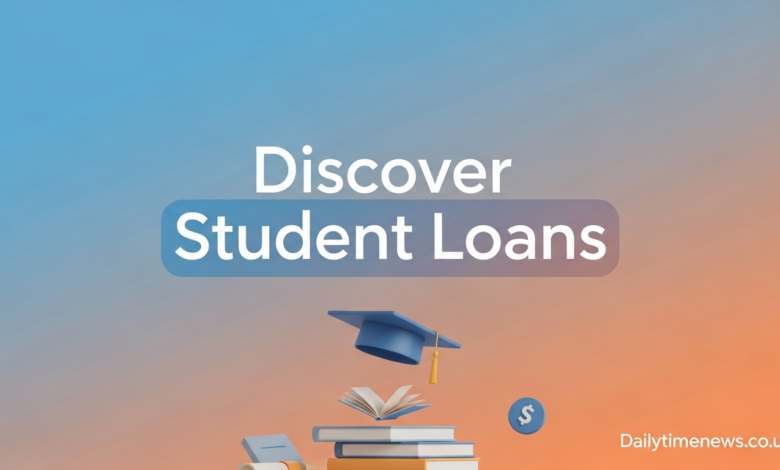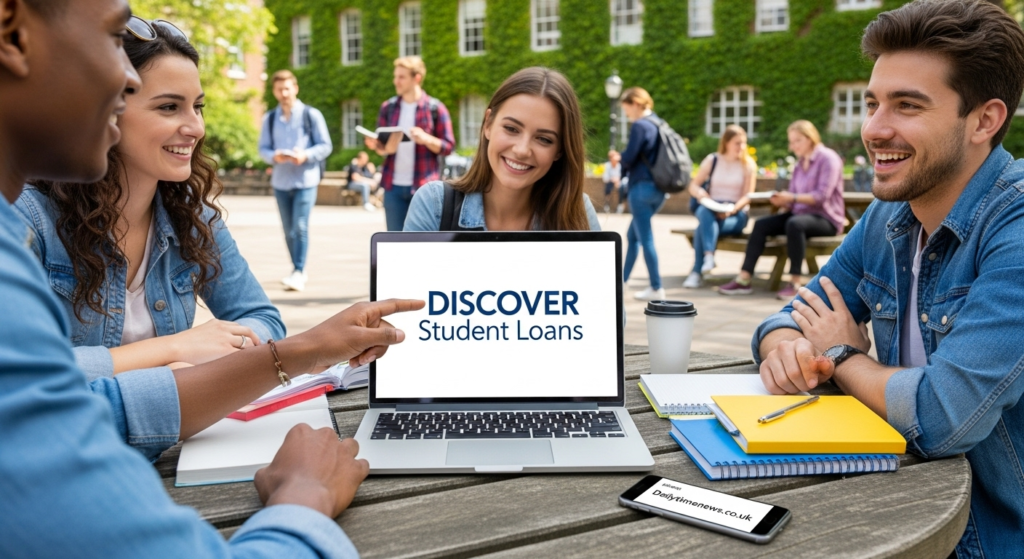Discover Student Loans: Smart Funding for Your College Dreams

Introduction
Paying for college can feel overwhelming. Tuition costs keep rising, and you’re left wondering how to bridge the gap between scholarships, grants, and what your family can afford. If you’re exploring ways to finance your education, Discover student loans might be worth your attention.
I’ve spent years researching student loan options, and Discover consistently stands out for its transparency and borrower-friendly features. This isn’t just another financial product. It’s a tool that could help you reach your educational goals without drowning in confusing terms and hidden fees.
In this article, you’ll learn everything about Discover student loans. We’ll cover eligibility requirements, interest rates, repayment options, and how they compare to other lenders. By the end, you’ll know whether Discover is the right fit for your college funding needs.
What Are Discover Student Loans?
Discover Financial Services offers private student loans to help cover education costs that federal loans and financial aid don’t fully address. These loans can pay for tuition, books, housing, and other college expenses.
Discover provides loans for undergraduate students, graduate students, and parents. You can borrow up to 100% of your school-certified costs. This means if your college says you need $15,000 for the semester, Discover can potentially cover that entire amount.
The company has been in the lending business since 1986. They’ve built a reputation for customer service and straightforward loan terms. Unlike some lenders that hide fees in fine print, Discover keeps things simple.
You won’t find origination fees or prepayment penalties with Discover student loans. That’s a huge advantage. Many competitors charge 1% to 5% just to process your loan.
Who Qualifies for Discover Student Loans?
Getting approved for Discover student loans depends on several factors. Understanding these requirements helps you prepare your application.
Basic Eligibility Requirements
You must be a U.S. citizen or permanent resident. The school you attend needs to be an eligible institution. Discover works with most accredited colleges and universities across the country.
You’ll need to be enrolled at least half-time. Full-time students often get better rates, but part-time students can still qualify.
Credit and Cosigner Considerations
Here’s where things get real. Most students don’t have established credit histories. That’s completely normal. Discover understands this reality.
If you’re an undergraduate student, you’ll likely need a cosigner. This is someone with good credit who agrees to be responsible if you can’t make payments. Parents often serve as cosigners.
Graduate students sometimes qualify without a cosigner if they have sufficient income and credit. The requirements are stricter, but it’s possible.
Your cosigner’s credit score matters significantly. Discover typically looks for scores above 660. Higher scores can help you secure lower interest rates.
Income Requirements
You or your cosigner need to demonstrate ability to repay the loan. Discover doesn’t publish exact income requirements. They evaluate your overall financial picture.
This includes current income, employment status, debt-to-income ratio, and credit history. Having a stable job or consistent income stream strengthens your application.

Types of Discover Student Loans Available
Discover offers three main loan products. Each serves different needs and borrower situations.
Undergraduate Student Loans
These loans help students pursuing bachelor’s degrees. You can borrow from $1,000 up to 100% of your certified education costs.
Interest rates vary based on credit and market conditions. Fixed rates provide stability. You know exactly what you’ll pay each month. Variable rates can start lower but may increase over time.
Discover offers a reward for good grades. If you maintain a 3.0 GPA or higher each year, you can get a 1% cash reward. That’s free money for doing well in school.
Graduate Student Loans
Graduate programs often cost more than undergraduate degrees. Discover provides loans for master’s programs, doctoral programs, and professional degrees.
The borrowing limits are higher for graduate students. You can cover the full cost of attendance. This includes tuition, fees, books, supplies, and living expenses.
Graduate students may qualify without a cosigner more easily than undergraduates. Your work experience and established credit can work in your favor.
Parent Loans
Parents who want to help their children pay for college can apply for parent loans. These loans are in the parent’s name, not the student’s.
This option works well when students can’t qualify on their own. Parents with strong credit can often secure better rates. The student isn’t responsible for repayment.
Interest rates for parent loans are competitive. Parents can also earn the 1% cash reward for their student’s good grades.
Interest Rates and Loan Terms Explained
Understanding how interest rates work saves you money over time. Discover offers both fixed and variable rate options.
Fixed vs Variable Rates
Fixed rates stay the same throughout your loan term. If you start at 5.99%, that’s what you’ll pay for 10, 15, or 20 years. This predictability helps with budgeting.
Variable rates change based on market conditions. They’re tied to the LIBOR index. When the market rate goes up or down, your rate adjusts.
Variable rates often start lower than fixed rates. This looks attractive initially. However, they carry more risk. Your monthly payment could increase significantly over time.
Most financial experts recommend fixed rates for student loans. The stability outweighs the potential short-term savings of variable rates.
Current Rate Ranges
Discover student loan rates change regularly based on market conditions. As of recent data, rates typically range from around 4% to 14% APR.
Your actual rate depends on multiple factors. Credit score plays the biggest role. Loan term length also affects your rate. Shorter terms usually come with lower rates.
The type of degree matters too. Undergraduate loans might have different rates than graduate loans. Career-training programs could have different pricing.
Loan Term Options
Discover offers flexible repayment terms. You can choose 10, 15, or 20-year repayment periods for most loans.
Shorter terms mean higher monthly payments but less total interest paid. A 10-year loan might have a $300 monthly payment while a 20-year loan might be $175. The 10-year option saves you thousands in interest.
Longer terms reduce your monthly burden. This helps if you expect a lower starting salary. You can always pay extra to finish early without penalties.
Repayment Options That Actually Help
Discover understands that students face different financial situations. They offer several repayment plans to match your needs.
Immediate Repayment
You start making full principal and interest payments right away. This option costs the least over the life of your loan.
Most students can’t afford this while in school. But if you can, you’ll save considerable money on interest charges.
Interest-Only Payments
You only pay the interest charges while you’re in school. Your loan balance doesn’t grow, but it doesn’t shrink either.
This keeps your debt manageable. Monthly payments might be $25 to $50 depending on your loan amount. It’s more affordable than full payments but still builds good financial habits.
Fixed Payment Option
Discover offers a flat $25 monthly payment while you’re enrolled. This payment goes toward interest charges.
This option provides simplicity. You know exactly what you owe each month. It won’t cover all your interest, so your balance will grow slightly. But it’s much better than making no payments at all.
Full Deferment
You can defer all payments until after graduation. Discover gives you a six-month grace period after you leave school.
This is the most common choice for students. It allows you to focus on studies without financial stress. The downside is that interest accrues and capitalizes. Your total loan balance increases significantly.
Benefits That Set Discover Apart
Several features make Discover student loans competitive. These perks add real value beyond just borrowing money.
No Fees
Discover charges zero origination fees. They don’t charge application fees, late fees, or prepayment penalties. This transparency is refreshing.
Other lenders might charge 1% to 5% upfront just to process your loan. On a $20,000 loan, that’s $200 to $1,000 gone immediately. Discover lets you keep that money.
Cash Rewards for Good Grades
The 1% cash reward for maintaining a 3.0 GPA is unique. On a $20,000 loan, that’s $200 back each year you qualify.
You submit your transcript once per year. If you meet the requirement, Discover sends the reward. It’s a nice incentive to stay focused on academics.
Cosigner Release Option
After making 12 consecutive on-time payments, you can apply to release your cosigner. You need to meet credit and income requirements.
This frees your cosigner from obligation. It also helps you build independent credit. Not all lenders offer this option at all, let alone after just one year.
Flexible Forbearance Options
Life happens. Sometimes you face financial hardship after graduation. Discover offers up to 12 months of forbearance if you qualify.
During forbearance, you can temporarily pause or reduce payments. Interest continues to accrue, but you won’t default on your loan. This safety net provides peace of mind.
How to Apply for Discover Student Loans
The application process is straightforward. Following these steps increases your chances of approval.
Step One: Gather Required Information
You’ll need your Social Security number, driver’s license, and school information. Have your expected graduation date ready. Know your program of study and enrollment status.
If you’re using a cosigner, they’ll need the same documentation. Collect recent pay stubs or tax returns to verify income.
Step Two: Complete the Online Application
Visit Discover’s website and start the application. The online form takes about 15 minutes. You’ll answer questions about yourself, your school, and your financial situation.
Be honest and accurate. Mistakes can delay approval. The system is secure and protects your personal information.
Step Three: School Certification
After approval, Discover contacts your school’s financial aid office. The school certifies your costs and enrollment. This confirms you’re eligible and verifies the amount you can borrow.
This step typically takes one to two weeks. Your school processes these requests regularly, so they know the procedure.
Step Four: Accept Your Loan
Once certified, you’ll receive final loan terms. Review the interest rate, payment schedule, and total amount carefully. Make sure you understand what you’re agreeing to.
If everything looks good, accept the loan electronically. Discover will send funds directly to your school. The school applies money to tuition and fees first. Any remaining amount goes to you for other expenses.
Comparing Discover to Other Student Loan Lenders
You have many options for private student loans. Understanding how Discover stacks up helps you make informed decisions.
Discover vs Sallie Mae
Sallie Mae is probably the best-known private student lender. They offer similar products and competitive rates.
Sallie Mae charges origination fees on some loans. Discover doesn’t charge any fees. That’s an immediate advantage for Discover.
Both companies offer the ability to release your cosigner. Sallie Mae requires 12 months of payments, same as Discover.
Sallie Mae has slightly more flexible career-training loan options. Discover focuses primarily on traditional degree programs.
Discover vs College Ave
College Ave is a newer lender focused exclusively on student loans. They offer quick approvals and good customer service.
College Ave charges a 1% fee on some loans. Again, Discover wins on the no-fee front. However, College Ave sometimes offers lower interest rates for well-qualified borrowers.
Both companies provide multiple repayment options while in school. College Ave has shorter minimum loan terms available, starting at five years.
Discover vs Federal Student Loans
Federal loans should always be your first choice. They offer fixed rates, income-driven repayment, and loan forgiveness programs. No private lender can match these benefits.
Federal loans don’t require credit checks for most programs. Everyone gets the same rate regardless of credit score. They provide more generous deferment and forbearance options.
Only consider Discover and other private loans after maxing out federal options. Use private loans to cover the gap between federal aid and total costs.
Common Mistakes to Avoid
Students make predictable errors when borrowing for college. Learning from others’ mistakes saves you money and stress.
Borrowing More Than You Need
Just because you’re approved for $30,000 doesn’t mean you should take it all. Borrow only what you absolutely need. Remember, you’ll pay interest on every dollar.
Calculate your actual expenses carefully. Include only necessary costs. That spring break trip can wait until after graduation when you have income.
Ignoring Federal Loans First
Private loans like Discover should supplement federal loans, not replace them. Always complete your FAFSA. Accept all federal loans offered before considering private options.
Federal loans provide protections that private loans can’t match. Don’t skip this crucial step.
Choosing Variable Rates Without Understanding Risk
Variable rates look appealing because they start lower. But they can increase dramatically. If rates rise 3% over 10 years, your payment could jump $100 or more monthly.
Unless you plan to pay off the loan very quickly, fixed rates provide better long-term value. The peace of mind is worth a slightly higher starting rate.
Not Making Any Payments While in School
Even small payments during school reduce your total debt. Interest doesn’t take a break just because you’re studying.
If you can afford $25 or $50 monthly, do it. Every payment counts. Your future self will thank you when the balance is smaller at graduation.
Failing to Communicate With Your Lender
If you run into trouble making payments, contact Discover immediately. They can help with forbearance, deferment, or alternative payment arrangements.
Ignoring the problem makes it worse. Late payments damage your credit. Default ruins your financial future. Lenders want to work with you, but you have to reach out.
Real Talk: Is Discover Right for You?
Every borrower’s situation is unique. Discover student loans work well for some people and not for others.
When Discover Makes Sense
Consider Discover if you’ve maxed out federal loans and still need money. If you have a creditworthy cosigner, you’ll likely qualify for competitive rates.
The no-fee structure saves you money from day one. The grade-based reward provides extra motivation and cash back.
If you value good customer service and straightforward terms, Discover delivers. Their online platform is user-friendly. Customer support receives consistently positive reviews.
When to Look Elsewhere
If you have poor credit and no cosigner, you might not qualify for Discover. Some lenders specialize in higher-risk borrowers, though rates will be much higher.
If you’re pursuing a very short-term program or certificate, other lenders might offer better options. Discover focuses on traditional degree programs.
Students who need very small loans (under $1,000) might find better local options through credit unions. The paperwork for Discover might not be worth it for tiny amounts.
Tips for Managing Your Student Loans Successfully
Getting the loan is just the beginning. Managing it properly sets you up for financial success.
Track Everything
Keep records of all loan documents, payment confirmations, and correspondence with Discover. Create a folder on your computer and email.
Know your exact balance, interest rate, and payment due date. Set calendar reminders so you never miss a payment.
Create a Repayment Strategy
Before graduation, develop a realistic repayment plan. Calculate what your monthly payment will be. Compare that to your expected salary.
If the payment seems high relative to your income, consider income-driven repayment for federal loans. For private loans, consider refinancing after building good credit.
Pay More When Possible
Any extra money you can put toward student loans saves interest and shortens your repayment period. Even an extra $50 monthly makes a significant difference.
Apply windfalls like tax refunds or bonuses directly to your student loans. Paying off high-interest debt is one of the best investments you can make.
Build an Emergency Fund
Before aggressively paying down student loans, save three to six months of expenses. Emergencies happen. You don’t want to miss loan payments because your car broke down.
Balance debt repayment with saving. Both are important for financial health.
Monitor Your Credit
Your student loan payments affect your credit score. Make every payment on time. Set up autopay to avoid accidental late payments.
Check your credit report annually at AnnualCreditReport.com. Make sure your Discover loan is reporting correctly. Dispute any errors immediately.

Conclusion
Discover student loans offer a solid option for financing your education. With no fees, competitive rates, and borrower-friendly features, they deserve serious consideration.
Remember to exhaust federal loan options first. Federal loans provide unique protections that private lenders can’t match. Use Discover and other private loans only to fill the gap.
Take time to understand the terms before signing. Calculate your total repayment amount. Make sure you can afford the monthly payments after graduation.
Education is an investment in yourself. Choose your funding carefully. With the right approach, you can earn your degree without being crushed by debt.
What’s your biggest concern about paying for college? Understanding your priorities helps you make the best borrowing decisions for your situation.
Frequently Asked Questions
Can I use Discover student loans for any college?
Discover works with most accredited colleges and universities in the United States. Your school must be eligible for Title IV federal student aid programs. Check with Discover or your school’s financial aid office to confirm eligibility before applying.
How long does the application process take?
The online application takes about 15 minutes to complete. You’ll receive a credit decision within minutes in most cases. However, school certification can take one to two weeks. Plan ahead and apply well before your tuition payment deadline.
Can I refinance my Discover student loan later?
Yes, you can refinance student loans from any lender, including Discover. After graduation, if you have good credit and stable income, refinancing might lower your interest rate. Discover also offers refinancing through their student loan refinancing product. Shop around for the best rates.
What happens if I drop below half-time enrollment?
If you drop below half-time status, your grace period begins. You’ll have six months before repayment starts. Notify Discover immediately if your enrollment status changes. They can help you understand your options and avoid unexpected payments.
Does Discover report payments to credit bureaus?
Yes, Discover reports your payment history to all three major credit bureaus. On-time payments help build your credit score. Late or missed payments damage your credit. This makes autopay a smart choice to protect your credit history.
Can I change my repayment plan after graduation?
Your in-school payment option ends when you graduate or drop below half-time. At that point, you enter standard repayment. Contact Discover if you face financial hardship. They offer forbearance and other assistance programs for qualifying borrowers.
Is the 1% cash reward automatic?
No, you must apply for the reward annually. Submit your transcript showing a 3.0 GPA or higher for the previous year. Discover reviews your submission and issues the reward if you qualify. Set a reminder each year so you don’t forget to claim this benefit.
Can international students get Discover student loans?
Discover requires borrowers to be U.S. citizens or permanent residents. International students don’t qualify on their own. However, if an international student has a cosigner who is a U.S. citizen or permanent resident, they might be able to apply. Check with Discover for specific situations.
Also Read Dailytimenews.co.uk



